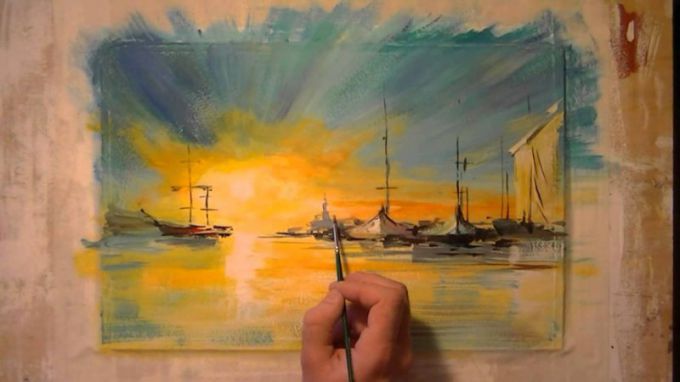You will need
- Paper, brushes, acrylic paint, water
Instruction
1
Prepare surface. To paint with acrylic on paper (thick is better, watercolor, for example), wood, glass, plastic and other materials. After drying, the paint will turn into a thin elastic film, resistant to water, light, mechanical stress. Depending on the core material, select an acrylic dye for smooth or porous surfaces.
2
To experience with acrylic you will only set of the six colors. They are easy to mix, and when applying a new layer on the dried up previous shades will not mix and will not give the effect of dirt, as often happens with gouache.
3
To create a translucent layer dilute the paint with water – you can do it in the palette or any convenient jar. Very diluted paint, apply with a soft brush: they better absorb and give up liquids. Try to put a few translucent layers of diluted acrylic paint (each time waiting for the previous layer is dry), you get an interesting effect soft "glow" of different colors through each other. For slightly diluted acrylic paint, use a synthetic nylon brush.
4
For drawing undiluted acrylic take a hard synthetic brush, rectangular and wide, so you can quickly cover a rich dense color a large surface. The movement should be quite fast, because acrylic paint dries quickly. A thin layer dries in a couple of minutes, thick – 15-20. For accurate drawing of small details, take a kolinsky brush.
If in the process of drawing you made a mistake or the hand tremble, do not worry. Damaged fragment can be covered with a new layer of thick acrylic and fix the problem.
If in the process of drawing you made a mistake or the hand tremble, do not worry. Damaged fragment can be covered with a new layer of thick acrylic and fix the problem.
5
Using acrylic paints you can create different textures. Apply it with a brush of bristles with jagged edges, and the pattern is difficult to be distinguished from oil painting. Apply on wet paper in a few colours around, and then quickly connect all the rows of clean wet brush and they will mix, Recalling the watercolour.
6
To complete the picture, you can use markers, gel and ballpoint pens and even coloured pencils on top of the dried acrylic.
Note
Dried acrylic paint is very difficult to wash off. During operation, keep the brush in water, and after finished drawing, carefully rinse them with water.
Useful advice
Dilute acrylic paint with water or acrylic binder. When diluted with water the durability of the paint is reduced.
To secure the picture it is possible (but not required) to use acrylic varnish with a matte or gloss effect.
To secure the picture it is possible (but not required) to use acrylic varnish with a matte or gloss effect.
